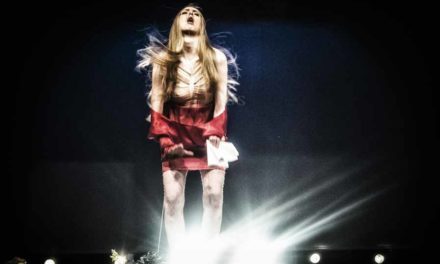Grand sets, lavish costumes, technical extravaganza, celebrity actors, and pricey tickets — commercial theatre is trending as a promising genre that attempts to match audience expectations with the economics of art. Looking to tap newer markets and to shift the onus from sponsors and grants to audience engagement, upscale productions are tipping the scales to move the theatre ecosystem towards self-sustaining strategies.
The upcoming play Ovee premières in Delhi this weekend with a star cast featuring film actor and director Rohit Roy, television actor Sayantini Ghosh and theatre artist Ridhima Bedi. Directed by Aniket Patil, the play already had successful runs in Marathi and Gujarati and has been adapted for Hindi theatre at an elevated scale. “This is something new to Hindi theatre since the horror genre has hardly been explored,” says Patil.
“The format of horror is common in cinema, but it would be a fresh experience for theatre audience with live special effects and lighting that are quite creatively conducted. Without the barrier of the cinema or television screen, it would be a different experience altogether.”
The challenge for commercial theatre is to consistently innovate and present offerings to enthuse the audience anew, in terms of content, aesthetics, genres, production design or performances.
Content is king
Produced by Felicity Theatre, Ovee is next in the line-up of plays that it has featured over the years, ranging from mythological dramas to romantic comedies. Producer and Managing Director, Rahul Bhuchar reflects,
“It is a technology-driven production that is high on special effects, a powerful script and brilliant actors, and quite different from our earlier productions.”
As a producer, he looks for novelty in each production that would be of value to the audience,
“We must understand that audience puts in their time and money to watch theatre. We cannot offer mediocre and unprofessional plays and then complain that theatre doesn’t have an audience or that they want free shows. Audiences are glad to pay and flock to the theatre, but as theatre professionals we must step up and live by their expectations of providing a good quality production.”
He points out that each play they produced had unique points that they knew would hit home with the audience.
“For instance in our longest running production, Mahabharata — the visuals and costumes were stunning. Another approach is to get celebrity actors, focus on good scripts and have no compromise on production design.”
At any point of time, he has a team of 40-50 writers engaged in writing, researching or adapting content for the next production.
While commercial theatre may draw huge footfalls, it is also known to resort to spectacular gimmicks and marketing stunts that drive the content to populist aesthetics and dilutes the gravitas. Theatre director Atul Satya Koushik of The Films and Theatre Society, offers a perspective on this aspect,
“A big problem with the term commercial theatre is that it ends up segregating theatre in terms of content. It is often contrasted with experimental and artistic theatre whose content is supposed to be more meaningful. But actually what commercial theatre means is that which is offsetting the production costs with the ticket-generated revenue. Today, we treat entertainment as a commodity, but that does not mean that it is less creative or less artistic in any way. It is high time we treat the theatre as any other market, each play may not be at a grand scale, but it must be self-sustaining.”
Both Bhuchar and Koushik began with mythological themes and expanded the repertoire to other genres. Koushik opines,
“At one point I realised that the audience had started branding me into one genre, then I tried my hand at comedy, social commentary. Our latest production (Ballygunge 1990) is a thriller.”
Market mantra
In 1999, when M Sayeed Alam left his job in journalism to pursue theatre, he realised that theatre has a skewed economics.
“The scene was very dismal in those days. Shri Ram Centre basement was one of the few affordable venues with a 140-seater capacity, and maximum ticket rates were ₹20. I did all kinds of calculations only to reach the conclusion that whatever you do you will not be able to earn much out of this arrangement.”
He established his own theatre company, Pierrot’s Troupe, that decided to experiment with a slightly different model.
“We explored the commercial angle of theatre. And honestly, a large part of the credit goes to the theatre artists at that time who did not charge anything and were basically earning their living from other day jobs. If I were to pay the artists as per their performance and experience, it would not have been possible for us to sustain the troupe!”
Grants and sponsorship can be sporadic and inconsistent. The need for a different model pushed the producer-directors to try out new avenues of reaching audiences directly. Bhuchar remembers a time on one of their early shows where there were hardly 5-10 people in the audience.
“It was a disastrous beginning, but I was self-motivated, and put in my own capital to gradually build a market for theatre. Now we have houseful shows running at auditoriums with 650 or more capacity! Finding sponsors is impossible in this field. So, my question was, if we offer something good, why would people not buy tickets? The whole challenge was to create that awareness, and have a flourishing market for theatre.”
Production value
Most grand productions are anchored in stunning visuals and spectacular stagecraft. Ovee features sets imported and assembled from the US and promises a technical stunner. Bhuchar reflects, “The live set-up for a horror show is very risky, if it goes wrong you can become a laughing stock.” In an unusual strategy, Bhuchar decided to hold rehearsals on the live set to have the actors perfect their timing with the special effects.
“We booked the auditorium for a month, only for rehearsals, without an audience! Of course this increased the production cost many times, but this was important. There are multiple stage hands, along with hydraulics to manage the set. The entire set also undergoes a complete change during the interval.”
On the other hand, Alam’s approach to production costs is radically divergent,
“I focus on unique, fresh and engaging scripts rather than expensive sets. In fact, audiences are thrilled with excellent scripts and performances. By keeping our costs for sets and costumes minimal, we have been able to run successfully with more than 500 shows for each production.”
In 2002, he decided to bring Tom Alter on stage as a celebrity actor who already had a huge fan following. “Usually people see theatre as a stepping stone to reaching cinema. We wanted to see if indeed we can change this concept.”
Bhuchar points out that one of the observable successes of commercial theatre has been the possibility of reversing this trend, “Nowadays, screen actors are keen to come to theatre and this is the thrill and possibility that stage can offer if done well.”
Challenges ahead
The absence of suitable venues, even in a city like Delhi, is a worrying factor for most producers. Bhuchar points out,
“The most head-breaking activity at every stage in the field is to get collaborations with auditoriums, there are hardly any that can support this scale of production.” Koushik points out, “Theatre is an actor-dependent medium. Sometimes with celebrity actors it is very challenging to coordinate rehearsal schedules and shows.”
For Alam, it is important for theatre groups to sustain for longer periods, “I am amazed, you have 20-25 productions happening in Delhi every weekend by new groups that are mushrooming, but then most of these do not survive beyond 3-4 years.”
Yet, commercial, self-sustaining theatre is a playing ground of possibilities. New markets have opened up spaces for new players, and for unique experiences that rely on audiences as the true patrons of the art.
This article was originally published on The Hindu. Reposted with permission. Read the original article.
This post was written by the author in their personal capacity.The opinions expressed in this article are the author’s own and do not reflect the view of The Theatre Times, their staff or collaborators.
This post was written by Shrinkhla Sahai.
The views expressed here belong to the author and do not necessarily reflect our views and opinions.


















